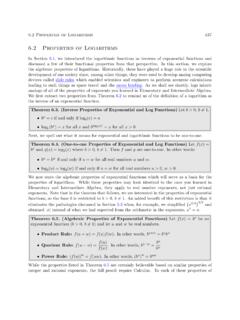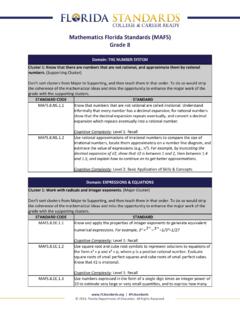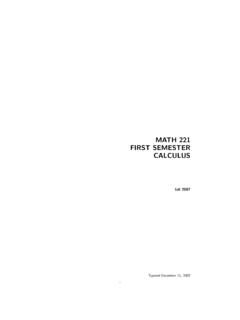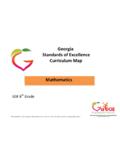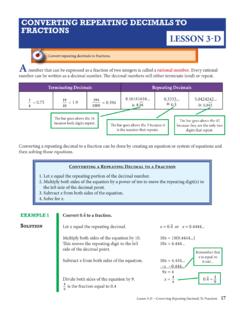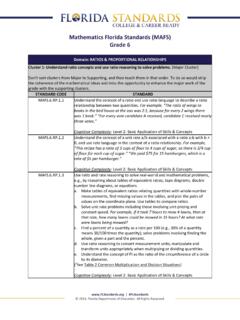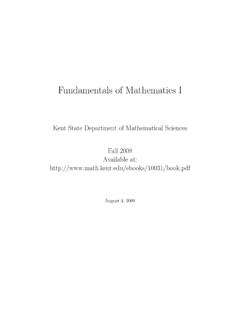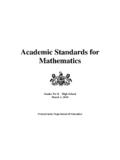Transcription of Using Order of Operations
1 ARI Curriculum Companion Using Order of Operations and Exploring properties Virginia Department of Education 1 Introduction The lessons in this section focus on Order of Operations and evaluating numerical expressions. Students will also investigate and recognize properties of real numbers used to solve an equation. These lessons form an outline for your ARI classes, but you are expected to add other lessons as needed to address the concepts and provide practice of the skills introduced in the ARI Curriculum Companion. Some of the lessons cross grade levels, as indicated by the SOL numbers shown below. This is one method to help students connect the content from grade to grade and to accelerate. Standards of Learning Order of Operations The student will evaluate whole number numerical expressions, Using the Order of Operations limited to parentheses, addition, subtraction, multiplication, and division.
2 The student will evaluate whole number numerical expressions, Using the Order of Operations . The student will a) simplify numerical expressions involving positive exponents, Using rational numbers, Order of Operations , and properties of Operations with real numbers; and The student will apply the Order of Operations to evaluate algebraic expressions for given replacement values of the variables. properties of Real Numbers The student will investigate and recognize the distributive property of multiplication over addition. The student will investigate and recognize a) the identity properties for addition and multiplication; b) the multiplicative property of zero; and c) the inverse property for multiplication. The student will apply the following properties of Operations with real numbers: a) the commutative and associative properties for addition and multiplication; b) the distributive property; c) the additive and multiplicative identity properties ; d) the additive and multiplicative inverse properties ; and e) the multiplicative property of zero.
3 The student will a) simplify numerical expressions involving positive exponents, Using rational numbers, Order of Operations , and properties of Operations with real numbers; and The student will c) identify properties of Operations used to solve an equation. Table of Contents Lesson plans pertaining to the following Standards of Learning are found in this section. Click (or CTRL+click) on each to jump to that lesson. SOL , .. 2 SOL , .. 6 SOL , .. 10 SOL , ,d,e .. 14 SOL .. 17 SOL .. Coming soon SOL .. 24 SOL .. Coming soon ARI Curriculum Companion Using Order of Operations and Exploring properties Virginia Department of Education 2 SOL , Lesson Summary Students discover the Order of Operations , Using the areas of rectangles. (45 minutes) Materials Overhead transparency of three rectangles Copies of the attached worksheet Warm-up Review with students the process of finding the area of a rectangle.
4 Use an overhead transparency to display three rectangles with the dimensions (9" x 4", 9" x 5", and 9" x 8") of each rectangle shown. Ask students to explain the most direct way to find the total area of any two of these rectangles. They should recognize that the most direct way is by finding the area of each rectangle and then adding the two areas, , 9 4 = 36; 9 5 = 45; 36 + 45 = 81. Ask them to explain the most direct way to find the total area of all three rectangles. (Find the area of each, and then add the three areas.) Lesson 1. Put the following problem on the board: 4 3 + 2 5 = x. Have students solve the problem and then share their answer with a partner. Ask the students whether anyone got an answer of 70. If so, ask how them how they got that answer. They will probably say that they multiplied 4 and 3 to get 12, then added 2 to 12 to get 14, and finally multiplied 14 by 5 to get 70.
5 Ask the students if anyone got an answer of 22. If so, ask how they got that answer. The students who got this answer should explain that they multiplied 4 by 3 to get 12, then multiplied 2 by 5 to get 10, and finally added 12 and 10 to get 22. Discuss with the students why Using these two different procedures would give such different answers. 2. Have students write an expression to model the process they used in the warm-up to find the total area of two rectangles. Students should write one of the following expressions: 9 4 + 9 5, 9 4 + 9 8, or 9 5 + 9 8. Select one of these expressions, and use it to model on the board the two procedures used in the warm-up: (1) doing all Operations left to right and (2) doing all multiplications first and then doing addition. 3. Have students work in pairs to construct an explanation of why they must use the second procedure when finding the area of two rectangles.
6 Allow plenty of time for discussion. 4. Allow pairs time to present their explanations. At the end, summarize the discussion to explain why the second procedure is correct. 5. Have the students write a rule, based on the discussion, for simplifying expressions that involve multiplication and addition. The rule should state that all multiplication must be done before any addition. 6. Have the students write an expression to find the total area of all three rectangles from the warm-up ( , 9 4 + 9 5 + 9 8), and have students use their rule to simplify the expression. 7. Have the students work in pairs to see if there is another way to solve their original warm-up problem. Since the rectangles have one dimension the same, they could be put next to each other to create one big rectangle. For example, the 9 x 4 and 9 x 5 rectangles together create a 9 x 9 rectangle with an area of 81.
7 Have students write an expression that models the above approach. One expression could be 9 (4 + 5). To simplify this expression, explain that 4 and 5 need to be added first and then the sum multiplied by 9 to get 81. Have students write a rule for simplifying expressions that involve parentheses and multiplication. The rule should state that all expressions inside of parentheses must be simplified before any multiplication. 8. Ask the students to simplify 32 and then add 5 to the answer. Have the students write an expression that models the problem. Students will most likely write 32 + 5. Explain that the commutative property allows the expression also to be written 5 + 32. Have the students write a rule for simplifying ARI Curriculum Companion Using Order of Operations and Exploring properties Virginia Department of Education 3 expressions that involve exponents and addition.
8 The rule should state that all exponents must be simplified before any addition. 9. Have students write a new rule that combines the three rules they have written. The rule should state that when simplifying, expressions inside parentheses must be simplified first, then all exponents must be simplified, then all multiplication is done, and, finally, all addition is done. Explain that this Order of Operations rule includes division with multiplication and subtraction with addition. Multiplication and division must be done from left to right first, and then addition and subtraction is done from left to right. 10. Help the class create a complete Order of Operations rule similar to the following: It might be helpful for students to see how to organize the Order of Operations in a numbered list of steps, as shown below: 11.
9 Have students create and write two expressions, each containing parentheses, exponents, and all Operations . On a separate sheet of paper, have them simplify their expressions, showing each step in the Order of Operations and the final answer. Have them exchange their problems with a partner, simplify each other s expressions, and discuss the problems until agreement is reached on the correct Order of Operations and final answer. Reflection Have students complete the Simplifying Expressions worksheet. When simplifying, do all expressions inside parentheses first, then all exponents, then all multiplication and division Operations from left to right, and finally all addition and subtraction Operations from left to right. 1. Do any work within parentheses ( ) or other grouping symbols [ ] first. 2. Do any work with exponents (powers) or roots.
10 3. Do any multiplication and division in Order from left to right. 4. Do any addition and subtraction in Order from left to right. ARI Curriculum Companion Using Order of Operations and Exploring properties Virginia Department of Education 4 Name: Simplifying Expressions Simplify each expression, showing each step in the Order of Operations . To the right of each step, identify the step as parentheses, exponents, multiplication, division, addition, or subtraction. Example (4 + 5) 4 32 + 9(2) 9 4 32 + 9(2) parentheses addition 9 4 9 + 9(2) exponents 36 9 + 18 multiplication, left to right 27 + 18 subtraction, left to right 45 addition 1. 9 23 2. 72 (7 + 8) 4 3. 64 4 23 + 7 4. 3 + 7(23 6)2 ARI Curriculum Companion Using Order of Operations and Exploring properties Virginia Department of Education 5 Name: Simplifying Expressions ANSWER KEY Simplify each expression, showing each step in the Order of Operations .











